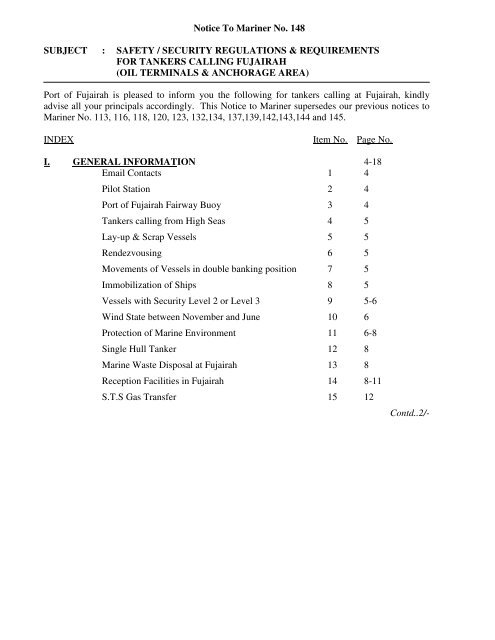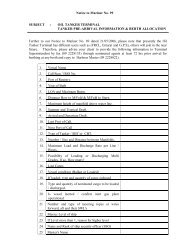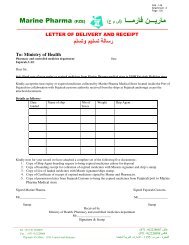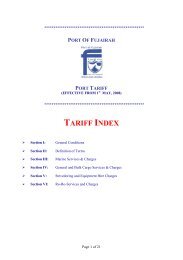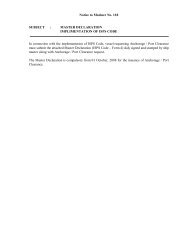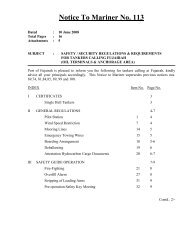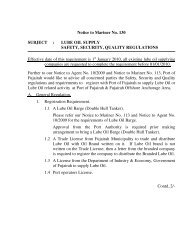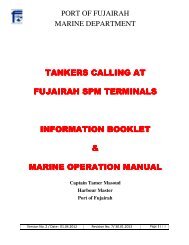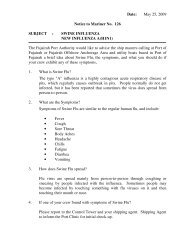SAFETY / SECURITY REGULATIONS ... - Port Of Fujairah
SAFETY / SECURITY REGULATIONS ... - Port Of Fujairah
SAFETY / SECURITY REGULATIONS ... - Port Of Fujairah
Create successful ePaper yourself
Turn your PDF publications into a flip-book with our unique Google optimized e-Paper software.
Notice To Mariner No. 148SUBJECT : <strong>SAFETY</strong> / <strong>SECURITY</strong> <strong>REGULATIONS</strong> & REQUIREMENTSFOR TANKERS CALLING FUJAIRAH(OIL TERMINALS & ANCHORAGE AREA)<strong>Port</strong> of <strong>Fujairah</strong> is pleased to inform you the following for tankers calling at <strong>Fujairah</strong>, kindlyadvise all your principals accordingly. This Notice to Mariner supersedes our previous notices toMariner No. 113, 116, 118, 120, 123, 132,134, 137,139,142,143,144 and 145.INDEXItem No. Page No.I. GENERAL INFORMATION 4-18Email Contacts 1 4Pilot Station 2 4<strong>Port</strong> of <strong>Fujairah</strong> Fairway Buoy 3 4Tankers calling from High Seas 4 5Lay-up & Scrap Vessels 5 5Rendezvousing 6 5Movements of Vessels in double banking position 7 5Immobilization of Ships 8 5Vessels with Security Level 2 or Level 3 9 5-6Wind State between November and June 10 6Protection of Marine Environment 11 6-8Single Hull Tanker 12 8Marine Waste Disposal at <strong>Fujairah</strong> 13 8Reception Facilities in <strong>Fujairah</strong> 14 8-11S.T.S Gas Transfer 15 12Contd..2/-
2INDEXItem No. Page No.Restrictions to Human Remains 16 12Life Boat Drill 17 12-13AIS Transmission 18 13Hot work inside cargo tanks of tankers 19 13Photography 20 14Ship Repair 21 14Import of Used Oil 22 15Approved Oil Spill Chemicals 23 15Changes in Ship’s Information 24 15Anchorage Clearance / Condition Certificate 25 16Last <strong>Port</strong> Clearance for vessels passing Suez Canal 26 16Master Declaration for Anchorage / <strong>Port</strong> Clearance 27 16Use of Distress Signalling Devices 28 16II SHIP CERTIFICATES 17III GENERAL <strong>REGULATIONS</strong> 18-22Mooring Lines 14 18Emergency towing Wire 15 19Boarding Arrangements 18 19-20Ballasting and De-ballasting 19 20-21Attestation of Hydrocarbon Cargo Documents 20 21-22IV<strong>SAFETY</strong> GUIDE LINES FOR CARGO OPERATIONAT FUJAIRAH OIL TERMINALS 22-26General 22-23Fire-Fighting 22 23-24Overfill Alarm 30 24Stripping Procedures 33 24-25Pre-operation Safety Key Meeting 34 25Unberthing Notice (FOTT) 39 26Contd..3/-
3INDEXItem No. Page NoVPORT OF FUJAIRAH BERTH CONSTRUCTION& DESIGN CRITERIALimitations & Tide Information A 26Main Quay B 27-28South Breakwater Berths (SBB) C 28-29<strong>Port</strong> of <strong>Fujairah</strong> Oil Terminals D 30-347 Meter Quay E 35Floating Jetty F 35VI VOPAK HORIZON FUJAIRAH LIMITED TERMINAL 35-41Berth Construction & Design CriteriaBerth No. 1 & 2 1 35-37Berth No. 3 & 4 2 37-38Berth No. 5 & 6 3 39-40Single Point Mooring (SPM) 4 41VII UNBERHTING NOTICE 41VIII S.T.S OPERATION 42-43Prohibited S.T.S Operation at off <strong>Port</strong> Limit 1 42Ship to Ship Regulation 2 42Certificates, General Regulations and SafetyGuide Operation 3 42S.T.S operation Plan 5 43S.T.S Hose Certificate 6 43Information Required 7 43IX <strong>SECURITY</strong> 44Entry Regulation A 44Instructions for Vessel’s crew at <strong>Fujairah</strong> Oil Terminal B 44X MARINE & PORT HANDLING CHARGES 45XI ATTACHEMENTS 45Contd..4/-
I. GENERAL INFORMATION41. Email ContactsYou can reach us on these email addresses,a. Harbour Master : hm_pof@fujairahport.aeb. Pilots <strong>Of</strong>fice : mar_pilots@fujairahport.aec. Security <strong>Of</strong>ficer : sec_pof@fujairahport.aed. <strong>Port</strong> Safety &Environnent <strong>Of</strong>ficer : Safety_pof@fujairahport.aee. Marine <strong>Of</strong>fice : mo_pof@fujairahport.aeAll Marine correspondences can be doneon this address while office hours. Afteroffice hours urgent requests can be sendto Control Tower for required action.f. Control Tower. : ct_pof@fujairahport.aeVessel arrival / departure information canbe sent to this address including ISPSforms. Enough notice should be given toControl Tower for any required services.2. Pilot Station<strong>Port</strong> of <strong>Fujairah</strong>, Oil Terminal 1, Oil Terminal 2, VHFL (Berths & SPM)25 O 08.8’ N & 056 O 24.0’ E3. <strong>Port</strong> of <strong>Fujairah</strong> Fairway BuoyCo-ordinates : 25 O 09.33’ N & 056 O 22.2’ ELight : FL.R.2sContd..5/-
54. Tankers Calling at <strong>Fujairah</strong> <strong>Of</strong>fshore anchorage & <strong>Port</strong> of <strong>Fujairah</strong> fromHigh Seas4.1 Tankers calling at <strong>Fujairah</strong> <strong>Of</strong>fshore Anchorage Area and <strong>Fujairah</strong> <strong>Port</strong>should be from official ports with valid Last <strong>Port</strong> Clearance.4.2 Tanker carried out S.T.S cargo operation at High seas will not bepermitted to call <strong>Fujairah</strong> <strong>Of</strong>fshore Anchorage Area or <strong>Fujairah</strong> <strong>Port</strong>Terminal.4.3 High Seas will not be considered as Last <strong>Port</strong>.4.4 A copy of Bill of Lading from the last cargo operation should besubmitted to Control Tower as a record of proof for obtainingAnchorage or <strong>Port</strong> Clearance.5. Lay-up & Scrap Vessels.Vessels for lay-up or scrap are not permitted at <strong>Fujairah</strong> <strong>Of</strong>fshore AnchorageArea.6. Rendezvousing.Rendezvousing between steaming vessels or between steaming vessels andservice boats are prohibited at <strong>Fujairah</strong> <strong>Of</strong>fshore Anchorage Area.7. Movements of vessels in double banking positionMovements of vessels in double banking position (side by side) are strictlyprohibited at <strong>Fujairah</strong> <strong>Of</strong>fshore Anchorage Areas.8. Immobilization at <strong>Fujairah</strong> <strong>Of</strong>fshore Anchorage.<strong>Fujairah</strong> <strong>Of</strong>fshore Anchorage Area is clearly meant for fully operationalvessels. Special permission from Harbour Master should be taken in case if avessel required immobilization and accordingly the port will reserve astandby tug during immobilization.The stand by tug will remain inside harbour and charges apply as per <strong>Port</strong>Tariff. In case, if the vessel required assistance of tugs, then tugs will beprovided with charges as per <strong>Port</strong> Tariff.9. Vessels with Security Level 2 or Level 3.<strong>Port</strong> Security <strong>Of</strong>ficer will board all vessels calling F.O.A.A with securityLevel 2 or 3 to furnish the DoS with S.S.O.Inspection and transportation charges as per <strong>Port</strong> Tariff.Contd..6/-
6Vessels with Security Level 2 or Level 3 must leave from F.O.A.A once theyfinish receiving their services. These vessels are allowed to receive theirservices (Bunkering, De-slopping, Freshwater, Crew Change, Stores, etc..)for a maximum of 12 hours only.Following Conditions apply,a) Two Patrolling Boats will patrol near the vessel till sailing fromF.O.A.A, these Patrolling Boats will be charged as per <strong>Port</strong> Tariff.b) V.H.F Channel 8 should always be on watch for the conversationamong the vessel’s bridge, patrolling boat and the Control Tower.10. Wind State Between November and JuneThe “SHAMAL” condition frequently prevails with wind speed in excess of50 knots, and gusts up to 70 knots.These winds are variable with strong Westerly to Northwesterly squallslasting up to 2 days. Maximum wind force 10 BF mainly 5-6 BF Katabaticwinds in late afternoons and evenings.Shipmasters are requested to ensure that their vessels secured and with equaltension on all mooring ropes.Minimum moorings will be 3 head & 3 stern ropes, 2 breast’s rope and 2springs forward and aft.11. Protection of Marine EnvironmentA. Prohibited S.T.S Operation at <strong>Of</strong>f <strong>Port</strong> LimitAccording to the following U.A.E Federal Law, S.T.S tanker operationat off <strong>Port</strong> Limit is PROHIBITED,1. Federal Law No. (19) of 1993 concerning to the definition of territorialwaters of the United Arab Emirates,2. Federal Law No. (24) of 1999 for the Protection and Development ofthe Environment.All shipping Agencies & Marine Service providing companies based in<strong>Fujairah</strong> are noticed to do not involve in above activity.Contd..7/-
7Please follow the Regulation of S.T.S at “S” Area at <strong>Fujairah</strong> <strong>Of</strong>fshoreAnchorage Area. Your cooperation is requested to keep <strong>Fujairah</strong> watersclean from all types of pollution and to have safe marine operation.B. Ballast Water Managementi. Prohibition on Pumping out tank Wash (Oily mixture)And Dirty Ballast Water into SeaTime to time the coast of <strong>Fujairah</strong> up to Dibba is suffering from oilpollutions resulting from the dirty ballast water and oil mixtures pumpedinto sea by some irresponsible masters.According to the UAE Federal Law No. (24) of 1999 for the Protection andDevelopment of the Environment please note the following,ii.<strong>Port</strong> of <strong>Fujairah</strong> do not accept tanker to leave anchorage area tohigh seas for tank wash and back.<strong>Port</strong> of <strong>Fujairah</strong> do not accept last port of call of a vessel to benamed as "HIGH SEAS".All tank wash should be delivered to slop collecting companies.Tankers are prohibited from discharging any polluting substancefrom tank wash or ballast water into the Water Environment unlesssafety measures been taken to safeguard water environmentaccording to MARPOL requirements.Please note that the Water Environment extend up to 200 N.M fromthe shoreline.Exchange of Ballast water at F.O.A.A and in <strong>Port</strong> of <strong>Fujairah</strong> isprohibited.Special Area for the Gulf – MARPOL 73/78 Annex I &VThe Special Area has been designated in the Gulf on 01/08/2008.The discharge requirement in the Special Area is as per regulations 15& 34 of MARPOL Annex I and regulation 5 of MARPOL Annex V.Please find below the summary of discharge requirements,Disposal of Garbage from Ships according to MARPOL. Thisapplies to all ships regardless of size.It is prohibited to discharge any garbage into sea inside theSpecial Area except food wastes when the ship is more than 12nautical miles from the nearest land. This applies to all shipsand offshore platforms regardless of size.Contd..8/-
8The control of oil discharge (machinery space of all ships) inthe Special Area and outside the Special Area according toMARPOL 73/78 Annex I, which is shown in the attached table(Attachment 1a, 1b, 1c & 1d) announced by the "MarineEmergency Mutual Aid Centre" (MEMAC) and the "RegionalOrganization for the Protection of the Marine Environment"(ROPME).C. Grit Blasting Ship’s sides & PaintingGrit blasting ship’s sides & painting at <strong>Fujairah</strong> <strong>Of</strong>fshore AnchorageArea is prohibited as an effort to protect marine environment.D. Propeller Polishing using solventsPropeller polishing with solvents, grease, etc.. is strictly not allowed at<strong>Fujairah</strong> <strong>Of</strong>fshore Anchorage & in <strong>Port</strong> of <strong>Fujairah</strong>.12. Single Hull TankersSingle Hull tankers are no more accepted to call <strong>Fujairah</strong> <strong>Of</strong>fshoreAnchorage or <strong>Port</strong> of <strong>Fujairah</strong>.Single Hull Tankers for Primary requirements such as, bunkering,desloping, crew change, stores etc.. can be permitted in ballastcondition and they must leave immediately after receiving primaryservices. They are not allowed to wait for orders (maximum 24 hours).13. Marine Waste Disposal at <strong>Fujairah</strong>Holds & Hatch cleaning at <strong>Fujairah</strong> <strong>Of</strong>fshore Anchorage isstrictly prohibited.Grit blasting and water blasting is prohibited at <strong>Fujairah</strong><strong>Of</strong>fshore Anchorage & <strong>Port</strong> of <strong>Fujairah</strong>.Import of all kinds of scrap materials into <strong>Port</strong> of <strong>Fujairah</strong>is strictly prohibited.Under water hull cleaning permitted with prior permission.14. Reception Facilities in <strong>Fujairah</strong>.Facilities available for the proper disposal of the below listed marinewastes in <strong>Fujairah</strong>,Contd..9/-
9i. Oily SludgeOily Sludge Treatment Facility available in <strong>Fujairah</strong>.Tank cleaning activity at <strong>Fujairah</strong> <strong>Of</strong>fshore Anchorage Area ispermitted to tankers dispose and treats their oily sludge atregistered treatment facilities in <strong>Fujairah</strong>. Transporting oilysludge by road or by sea from <strong>Fujairah</strong> <strong>Port</strong> to reception facilitiesoutside <strong>Fujairah</strong> is prohibited.Following procedures must be adopted for tank cleaning,a) Request specific permission from the Harbour Master to effecttank cleaning with 72 hr notice. The request should include,1. Vessel name and local agent.2. E.T.A and last port3. Name of Cleaning Company4. Number of labours5. Estimated duration of work.6. Estimated quantity of sludge.7. Receiving Facility and their confirmation.8. E.T.D and destination.b) Vessel's local agent should re-confirm 24 hours prior to tanker’sarrival and would liaise with Harbour Master for arrangingpermission for operation to start.c) Personnel involved in offshore job must obtain clearance fromDepartment of immigration.d) The <strong>Port</strong> Authority reserves the right to refuse or withdrawpermission for Tank Cleaning if cleaning company failed toadhere to the procedure.e) The <strong>Port</strong> Authority further reserves the right to appoint anindependent surveyor to verify any of the above informationprovided by vessel and its agent. In such cases surveyor wouldbe appointed at agent’s expense.Contd..10/-
10f) The Sludge Transport Statement as per the attached prescribedformat should be duly filled, stamped, attested from concernedauthorities and submitted to Marine Department immediatelyafter delivering sludge to the Reception Facility.g) Contact Details of reception facility in <strong>Fujairah</strong>Facility Name : Gulf Environment FZETelephone : 2281923Fax : 2281925Email : ecoref@emirates.net.aeii.Slop<strong>Of</strong>fshore & onshore slop collection facilities available at <strong>Fujairah</strong><strong>Of</strong>fshore Anchorage & <strong>Port</strong> of <strong>Fujairah</strong>.Contact details of Facilities in <strong>Fujairah</strong>.Sl. Facility Name Telephone Fax Email1. EMEPCO 2228840 2228841 att@akron.ae2. Fairdeal Marine Services 2228145 2228147 agency@fairdeal.ae3. Gulf Environment FZE 2281923 2281925 ecoref@emirates.net.aeiii.Domestic GarbageGarbage collection facility is available in <strong>Fujairah</strong> for collecting andproper disposal of domestic garbage from vessels calling at <strong>Fujairah</strong><strong>Of</strong>fshore Anchorage.The Contact Details of the facility:Facility Name : Green Peace Est.Telephone : 2281741Fax : 2281742Domestic garbage for the purpose of disposal must exclude thefollowing materials,a. Oily Waste.b. Oily related products.Contd..11/-
11c. Chemicals (liquid or solid).d. Radiating materials & nuclear wastes.e. All types of noxious substances.Domestic Garbage Delivery Receipts will be issued by <strong>Port</strong> of <strong>Fujairah</strong>on request for vessels calling <strong>Port</strong> of <strong>Fujairah</strong>. Green Peace Est. willissue Domestic Garbage Delivery Receipts to vessels calling at<strong>Fujairah</strong> <strong>Of</strong>fshore Anchorage. Related shipping agent has to submitthe attached declaration while requesting <strong>Port</strong> Clearance to get theDomestic Garage Delivery Receipt for vessels calling <strong>Port</strong> of <strong>Fujairah</strong>.Agencies are not allowed to issue any Garbage Delivery Receipt tovessels.iv.Expired MedicineReception facility is available in <strong>Fujairah</strong> for the proper disposal ofexpired medicines. The contact detail of reception facility is givenbelow and the disposal procedures attached (Attachment-2).Facility Name : Marine Pharma FZETelephone : 2228007Fax : 2228008VHF Call Sign : PORT CLINICEmail : fpclinic@emirates.net.aeWebsite : www.fujairahportclinic.co.aev. Distress Signalling DevicesDumping of expired distress signalling devices (Rocket ParachuteFlares, Smoke Signals, etc.) into sea is strictly prohibited at <strong>Fujairah</strong><strong>Of</strong>fshore Anchorage.The expired devices are therefore delivered to <strong>Fujairah</strong> Civil Defencefor the proper disposal through respective local agents.Local agents are requested to obtain prior permission from theDepartment of Explosives and Director General of Police priorcollecting aforesaid materials from ship for disposal purpose.Waste materials other than the listed above are not permitted todispose at <strong>Fujairah</strong> <strong>Of</strong>fshore Anchorage & <strong>Port</strong> of <strong>Fujairah</strong>.Contd..12/-
1215. S.T.S Gas TransferTransfer of Gas by S.T.S operation is not allowed at <strong>Fujairah</strong> <strong>Of</strong>fshoreAnchorage Area.16. Restrictions To Human Dead bodies.The Ministry of Interior will not accept human remains from any vessel if theincident happened at off <strong>Port</strong> limit. In case of any emergency, approval fromthe <strong>Fujairah</strong> Police and Local Authorities must be obtained prior bringingvessel to <strong>Fujairah</strong> <strong>Of</strong>fshore Anchorage or <strong>Fujairah</strong> <strong>Port</strong>.17. Lifeboat drill or Manoeuvring Test.a) At <strong>Of</strong>fshore AnchorageFurther to our follow up on the subject matter that transpired from theseminar conducted on 08/02/98, we are pleased to inform that the<strong>Fujairah</strong> Coast Guard has given approval to vessels anchored forconducting drill or manoeuvring test of their lifeboats at offshoreanchorage area under following condition.Vessels should not use the lifeboat to transfer any sort of material orpersonnel between vessels.The drill or manoeuvring test of the lifeboat must be conductedduring day light hours only.Movements of the lifeboat are restricted to close vicinity of thevessel and shall not exceed half nautical mile.Reaching shore under any circumstances, by the lifeboat isstrictly prohibited.Duration of the drill or test shall not exceed one hour.The lifeboat must carry its state flag and the name of ship & herport of registry must be clearly written on each bow sides.Agents must forward their request, 24 hr. in advance, to the MarineDepartment and obtain permission prior conducting the drill ormanoeuvring test. Agent must provide following information whenrequesting the permission.Contd..13/-
13Vessel name, Anchor position, number of lifeboats, Starting time &date and an undertaking confirming to above conditions.The Life Boat Drill at <strong>Fujairah</strong> <strong>Of</strong>fshore Anchorage Area could bepermitted for one time only.b) Inside HarbourLowering of lifeboat from vessel inside harbour can be permittedprovided the following statements by Shipmaster to Control Tower onV.H.F Radio,Lifeboat will be lowered up to water level only.Life boat will not be released from its hoisting hook.Life boat will be hoisted back immediately.Lowering of lifeboat in water for testing purpose should berequested by ship's agent with 24 hours notice provided withfollowing confirmation,* Life boat test in water will not be conducted if navy vesselinside harbour.* Shipmaster will take permission from Control Tower priorlowering and lifting of life boat.* Life boat will remain always near vicinity of the ship.* Life boat will not remain more than one hour in water.18. <strong>Fujairah</strong> <strong>Of</strong>fshore Anchorage - AIS TransmissionReproduction, distribution, publishing, transmission, modification totally orin part, sale and any other usage in general for any purpose, reason or causeof <strong>Fujairah</strong> <strong>Of</strong>fshore Anchorage Area by using AIS is hereby expresslyprohibited.Please note that the <strong>Port</strong> of <strong>Fujairah</strong> has jurisdiction as National Authorityin <strong>Fujairah</strong> waters.Legal actions will be taken against violators.19. Hot work inside Cargo tanks of Vessels at F.O.A.A & <strong>Port</strong> of <strong>Fujairah</strong>Conducting Hot Work inside Cargo Tanks of tankers at <strong>Fujairah</strong> <strong>Of</strong>fshoreAnchorage & in <strong>Port</strong> of <strong>Fujairah</strong> is strictly prohibited.Contd..14/-
1420. Photography in <strong>Port</strong> and at <strong>Fujairah</strong> <strong>Of</strong>fshore AnchoragePhotography is strictly prohibited in <strong>Port</strong> of <strong>Fujairah</strong> and at <strong>Fujairah</strong> <strong>Of</strong>fshoreAnchorage Area. Special permission must be taken from the concernedauthorities prior any photo / video shoot.Legal actions will be taken against violators and equipment used in thevideo/photography will be confiscated.Ship Master / skipper is also subject to legal actions if he permits anyoneonboard his vessel / utility boat to use video / still camera.21. Ship Repaira. Only Companies Registered for <strong>Of</strong>fshore Services with <strong>Port</strong> of<strong>Fujairah</strong> are permitted to attend ships for technical jobs.b. Technicians exceeding 10 required a letter from Marine Departmentprior permitting for attending ships at FOAA. Request for obtainingthis letter should be submitted with 72 hours notice and should containthe following information,i. Ship Nameii.iii.iv.IMO No.Vessel TypeVessel Condition (Ballast / Loaded)v. Whether Gas free (if Ballast)vi.vii.viii.ix.Scope of jobAttending CompanyNumber of TechniciansDuration of jobc. Confirmation to the following conditions required in addition to theabove,“The technicians will not involve in Tank Cleaning / De-mucking /hatch / hold cleaning operation onboard the vessel. No hot work willbe carried out in cargo tanks”.Contd..15/-
22. IMPORT OF USED OIL15Federal Environmental Agency reminded to us that the “Federal Law No. (24)of 1999 for the Protection and Development of the Environment” do notpermit import of any type of used oil.23. OIL SPILL RESPONSE – APPROVED OIL SPILL CHEMICALSPlease note that the following list of Oil Dispersants have been approved bythe United Arab Emirates Federal Environmental Agency and ROPME forcombating oil pollution,- COREXIT 9500 (for Sea and Beach, but not for Rocky Shore)- DASIC SLICGONE NS- FINASOL OSR-52- GAMLEN OD 4000 (PE 998)- NU CRU- RADIAGREEN OSD24. Changes in Ship’s InformationFollowing must be taken into consideration while changing Ship'sInformation (name, class, flag, ownership, agent, etc..),1. Any change in ship information should be informed to HarbourMaster’s <strong>Of</strong>fice 48 hours prior ship’s arrival.2. Changes such as, ship name, class, flag, ownership, agent, etc..shouldbe informed to Marine Department prior apply changes.3. Confirmation from the new shipping agency as local agent for thevessel (applicable if any change in agency).4. Confirmation from previous shipping agency on release of shippingagency (applicable if any change in agency).5. Copy of Provisional Certificate of Registry must be submitted priormaking changes on ship's hull (can be faxed to Marine Department).6. Ship Certificates as per Section II in this notice should be submittedimmediately after changing name with effected changes.7. Vessel and her local shipping agency should report immediately afterchange of ship’s particular.8. All attestations and other requests prior information change will beaccepted with the present name.Contd..16/-
1625. Issuance of Anchorage Clearance / Condition certificatePlease note, Anchorage Clearance Certificate is not compulsory to vesselscalling at <strong>Fujairah</strong> <strong>Of</strong>fshore Anchorage Area. Anchorage Clearance /Condition Certificate will not be issued to vessel calling at <strong>Fujairah</strong> <strong>Of</strong>fshoreAnchorage for short stay of less than 48 hours.Vessel engaged in cargo operation is exempted from the above regulation.26. Last <strong>Port</strong> Clearance for Vessels Passing Suez CanalPlease note that, any vessel passing SUEZ CANAL, arriving <strong>Fujairah</strong><strong>Of</strong>fshore Anchorage Area and requesting anchorage clearance from <strong>Port</strong> of<strong>Fujairah</strong> must submit last port clearance issued from PORT SUEZ or fromPORT SAID.Last port clearance submitted from any other authority will not be consideredfor situation mentioned above.27. Master Declaration for Anchorage ClearancePlease note that the Master Declaration should be filled by Master of the shipin the prescribed format (Attachment 3).The original duly filled Master Declaration form should be collected by agentfrom the ship while delivering of anchorage clearance and should besubmitted to marine office during office hours.28. Use of Distress Signalling Devices“Rocket Parachute Flare Smoke signals”The use of distress signalling devices such as “Rocket Parachute Flares” orSmoke Signalling devices” is strictly prohibited in <strong>Port</strong> of <strong>Fujairah</strong> and<strong>Fujairah</strong> <strong>Of</strong>fshore Anchorage unless there is valid reason for that.Above mentioned signalling devices are strictly not allowed to use infestivities.Storing of similar expired devices for celebrations is strictly not allowed.Proper disposal procedure mentioned in Section I-14-v to be followed for thedisposal of expired devices.Strict actions will be taken against violators.Contd..17/-
17II.SHIP CERTIFICATESTankers calling at <strong>Port</strong> of <strong>Fujairah</strong> Oil Terminals or F.O.A.A must have the followingvalid original statutory certificates & documents onboard,a) Load Line Certificateb) Cargo Ship Safety Construction Certificatec) Cargo Ship Safety Equipment Certificated) Cargo Ship Safety Radio Certificatee) Civil Liability Certificate issued from flag state (issued in accordance withprovisions of International Convention on Civil Liability for Oil PollutionDamage 1992)f) The International Oil Pollution Prevention (I.O.P.P) Certificate.g) Certificate of Ship’s Registryh) Certificate of Class (Hull & Machinery)i) Ship Sanitation Control Exemption Certificatej) ISM Safety Management Certificatek) Oil Record Books (Engine / Cargo & Ballast Operations)l) Shipboard Oil Pollution Emergency Plan (SOPEP)m) International Air Pollution Prevention Certificate (IAPP) (if applicable)n) International Ship Security Certificate (ISSC)o) Shipboard Marine Pollution Emergency Plan (SMPEP) (Chemical vessels only)p) NLS Certificate (Chemical vessels only)q) Certificate of Fitness (Chemical vessels only)r) S.T.S Operation Plans) S.T.S Hose Certificate (for S.T.S operation)Note : A check list is attached (Attachment : 4).Contd..18/-
18III.GENERAL <strong>REGULATIONS</strong>1. Berthing / Unberthing available round the clock.2. Vessels will be berthed on first come first served basis.3. Maximum allowed trim berthing / unberthing and alongside is 0.015 x LOA.4. All communication whilst Cargo Operation at Oil Terminals by U.H.F andthe Channels as decide by Terminal Superintendent.5. In case of Pollution or Fire, immediately inform the <strong>Port</strong> Control.6. Wind Speed restriction for Marine Loading Arms, Service position : 30 knots Operational Position : 40 knots Parked position : 80 knots7. Immobilising, Maintenance, Hot work, Tank cleaning and tank washing arenot allowed at Oil Terminals.8. Vessel vetting inspection allowed alongside Oil Terminal berths providedthat there will be no open tank inspection of cargo or ballast tanks, noshipside inspection by boat or stage and no life boats lowering.9. Crew change is allowed at <strong>Port</strong> of <strong>Fujairah</strong> Oil Terminals, but is not allowedat Vopak Terminal.10. Fresh water supply available through pipeline at <strong>Port</strong> of <strong>Fujairah</strong> OilTerminals.11. De-slopping by shore pipeline not available at the Terminals.12. Bunker/Slop barges/Utility Boats are not allowed whilst alongside OilTerminals.13. If there are any protrusions on ship’s hull, then ship’s agent should arrangepneumatic fenders.14. Mooring lines14.1 Ropes or wires acceptable.14.2 Wires should be used for mooring if available.14.3 If vessel uses ropes and wires at the same time, mixed mooring notallowed for leading in the same direction of head, stern, breast and orsprings.14.4 All mooring lines should be in good condition and tended to with sametension.Contd..19/-
1915. Emergency Towing WiresTwo Emergency Towing wires, length 50-55m, diameter according todeadweight stipulated in OCIMF Mooring guidelines, to be provided oneforward and one aft on the weather deck. The wires must be the typerecommended for good quality mooring wires, each wire must have two eyes.One eye goes over the ship’s bollard with extra four turns to take the tensionfor a safe and secured towing. The other eye must be maintained one metreabove the waterline at any freeboard. Please find attached sketch(Attachment 5).16. All personnel on deck shall wear appropriate personal protective gears.17. Transfer of Gas by S.T.S operation is not allowed at <strong>Fujairah</strong> <strong>Of</strong>fshoreAnchorage Area.18. Boarding Arrangementsa) Safe Embarkation and Disembarkation of the PilotThe master of a ship navigating in the port or approaches, shall affordsuch suitable “Weather lee” and speed reductions as dictated by thepractices of good seamanship in order to provide a safe embarkation ordisembarkation operation.Pilot ladder and associated equipment must comply with SOLASstandards and the requirements of International Pilot's Associationb) Pilot LadderA clean and efficient pilot ladder fitted with spreaders and manropesshall be made available for the pilot to embark or disembark. At nightthe ladder need to be illuminated with efficient and safe light.c) Supervision of Pilot LaddersThe rigging of pilot ladders for the embarkation/disembarkation ofpilots shall be supervised by a responsible ship’s officer, and shall beso effected that the ladder is well clear of any overboard discharge andthat each step of the ladder rests firmly against the side of the ship.Pilot boarding / disembarking shall also be supervised by a responsibleship’s officer.d) Accommodation and Pilot Ladder (combination)Whenever the height of the deck above the water level exceeds 30 ft(9.0 metres), the accommodation ladder shall also be used inconjunction with the pilot ladder and shall be lowered to above 22 ft(7.0 metres) above the water level with the pilot ladder immediatelyadjacent to the bottom of the accommodation ladder.Contd..20/-
20e) Mechanical HoistsNOTE:A mechanical hoist of an approved pattern shall be considered anacceptable alternative to a conventional pilot ladder to be used inconjunction with the accommodation ladder.Mechanical hoists whose operation relies upon a single wire are not of approvedpattern under these rules.19. Ballasting and Deballasting<strong>Port</strong> of <strong>Fujairah</strong> complies with 2004 International Convention for the Controland Management of Ship’s Ballast Water and Sediments to prevent thespread of harmful aquatic organisms carried by ship’s ballast water.Terminals do not have ballast water receiving facility and therefore, vesselscoming from other regions to <strong>Fujairah</strong> Oil Terminals should follow BallastWater Management Plan and exchange of ballast water at sea.In general, there are no restrictions on ballasting and de-ballasting forSegregated Ballast Tanks (SBT) during cargo loading or dischargeoperations. However, the following considerations should be taken intoaccount:• Ballast should not be loaded if it may cause the ship to exceedmaximum safe draft for the berth until sufficient cargo is discharged.• Also to keep freeboard within the restrictions of the Terminal LoadingArms and ship’s portable gangway elevation angle.• Deballasting to be carried out from seaward side, if required todeballast from port side then should be done through lower sea suction.• During deballasting to avoid pollution due to contaminated segregatedballast, the surface of the ballast should be sighted, prior tocommencing deballasting. When segregated ballast is beingdischarged, it is prudent to monitor the ballast discharged overboard bymeans of ballast water monitor or visual watch should be established.This may give the earliest warning of any inter-tank leakage betweencargo and ballast tanks that may have been undetected. The operationshould be stopped immediately in the event of contamination beingobserved.• If case of deballasting CBT tanker or heavy weather clean ballastcontained in cargo tanks is required then following terms and conditionshould be followed:• Contd..21/-
21a. Deballasting must be in daylight under inspection, testing andmonitoring of an approved petroleum inspector from TestingServices or Oil Laboratory.b. The Chemist Surveyor must board the vessel on arrival atanchorage prior berthing for sampling and testing the ballasttanks and double bottom tanks containing clean ballast water.The analysis & results must be informed to the <strong>Port</strong> ControlTower by fax and VHF.The ballast water must not have more than the specified 10 ppmoil content, then only the pilot shall board the vessel forberthing.c. After berthing, the vessel can start deballasting (in daylighthours only) under the observation of Chemist Surveyor. Everyhour he must take the samples and these samples to be testeduntil the discharge of clean ballast water is completed.d. If the surveyor observes any oil content while deballasting,discharging must be stopped immediately and <strong>Port</strong> Controlinformed through VHF radio, Channel 10 or 16.e. Final survey report must be submitted within 24 hours to theHarbour Master’s office.20. Attestation of Hydrocarbon Cargo DocumentsAttesting Hydrocarbon Documents such as, Statement of Exportationof Oil and its Derivatives, Discharge Certificate, Certificate of Originand Loading Certificate will be done only for Companies havebunkering Licenses in <strong>Fujairah</strong> and for tankers did cargo operation at<strong>Fujairah</strong> Oil Tanker or Vopak Horizon <strong>Fujairah</strong> Terminals. To getattested aforesaid certificates, concerned parties should follow thebelow instructions,a) Ship's E.T.A and survey company involved in Cargo operationshould be informed to Harbour Master's office 2 days inadvance. <strong>Port</strong> Authority will appoint an independent surveyor toattend Cargo Operation to check Quality, Quantity and CargoDocuments. Survey Charges, transportation and laboratorycharges will be on Agent's account or the requested party.Contd..22/-
22b) Attach copies from the following certificates and Originalsshould be available while attesting.i) Cargo Bill of Lading.ii)iii)iv)Certificate of Origin.Cargo Manifest.Certificate of Quantity.v) Certificate of Quality.c) All above documents must be submitted within a week from thedate of completion of cargo operation for attesting.IV<strong>SAFETY</strong> GUIDE LINES FOR CARGO OPERATION AT FUJAIRAH OILTLERMINALS1. All Equipment, Mechanical, Electrical Devices & Inert Gas System must bein full working condition and shall maintain readiness status consistent withSOLAS, MARPOL and OCIMF.2. Maximum operational wind speed is 30 knots.3. Inert Gas System should be operational if applicable and tanks should beinerted to less than 8% of Oxygen by volume. Tankers not fitted with IGsystem as per SOLAS chapter II-2 Regulation 60 and carrying oil other thancrude oil of flashpoint 60 0 C or above can be exempted.For Tankers below 20,000 DWT, IGS is not compulsory, but it must beworking and tanks must be inerted if fitted.For tankers from 20,000 to 40,000 DWT, SOLAS Exemption Certificate isrequired if IGS is not fitted.4. A properly rigged ship’s gangway or accommodation ladder with safety netshould be provided for the safe access of the shore personnel.5. Tanker to be free from internal / external leakage and all cargo systems to befully operational.6. Stress calculations for cargo and ballasting executed and shall be withinrecommended safety limits. Cargo load and or discharge plan shall be readyas applicable.7. All navigation, mooring, lighting equipment, mooring communications andengines fully operational.Contd..23/-
238. Radars to be switched off while alongside berth.9. VHF and AIS either switched off or on low power.10. GMDSS equipment grounded, MF/HF to be switched off.11. Pump rooms adequately ventilated on exhaust mode and illuminated alongwith fixed oxygen / gas detection and monitoring systems, which should befully operational and running.12. Fixed means of communication inside pump rooms from cargo control roomto be fully operational with audible and visual alarms.13. Bilge high level alarms to be in working condition.14. Deck lighting to be fully operational.15. Propeller to be fully submerged (maximum as is possible).16. Manifold drip trays to be clean, dry and without any traces of oil.17. All scuppers on weather deck to be plugged and chocked.18. All Stores, Engine Room and Accommodation external doors to be closed.19. All vents to be trimmed to exclude entry of cargo vapours insideAccommodation and Engine Room / Machinery Spaces.20. Air conditioning system to be in recirculation mode, or to be fitted with gasdetection system at the Fresh Air intake vents.21. Wilden pumps to be rigged properly and earthed, ready for instant operation.22. Fire fighting equipment ready at the operation manifold, this includes,A- Dry Powder or foam fire extinguishers.B- Two fire hoses ready at forward and aft of the manifold.C- Fire plan including updated crew list with <strong>Port</strong>s name and date,stowage plan and MSDS for onboard cargo.D- International Shore Connection with requisite nuts/bolts/gaskets andspanners.E- Fire main to be kept pressurised throughout vessel stay at terminal.23. Anti Oil Pollution equipment ready at the manifold.24. Pressure gauges fitted at all manifolds on either side.25. Pressure Vacuum valves in good working condition.26. During loading operation hydrocarbon vapours to be released at high velocityfrom high velocity valves to facilitate dilution of hydrocarbon vapours in theatmosphere well clear of jetty level.27. All cargo and ballast tank covers to be closed and secured.
2428. Unused cargo and bunker connections secured with blanks fully bolted.29. All COT’s to be fitted with operational independent Overfill Alarms withvisual and audible means on main deck beside Cargo Control Room.30. All COT’s to be fitted with closed tank gauging system with remote readoutin cargo control room. This system should also have High level alarms foreach tank.Below conditions required to be fulfilled by the vessels not fitted withoverfill alarms and fixed tanks gauging system for cargo oil tanks,a. At least 3 nos. operational and MMC/UTI tapes onboard withcertificates.b. Vessel should not top off more than 2 cargo tanks at a time.c. Tanks should not be loaded more than 90% of their capacities.d. Number of cargo watch keepers increased to monitor not only toppingoff tanks but other tanks as well to confirm tanks levels aremaintaining.e. Each watch keeper must carry independent walkie talkie tocommunicate with cargo officer directly without any delay.31. Sampling only allowed with closed sampling devices and samplers.32. Oxygen and Acetylene bottles must be stowed inside the specified lockersand to be disconnected from the mains. No empty bottles outside the specificlockers.33. Stripping ProceduresAt Oil Terminal – 1, after completion of each loading or dischargingoperation the stripping of Loading Arms can be done by the followingoptions:i) Loading Arm Outboard assembly always to the vessel.ii)iii)Loading Arm riser & Inboard assembly stripping to the vessel orTo the User’s Line.At Oil Terminal – 2, after completion of each loading or dischargingoperation the stripping of Loading Arms and Dock Lines can be done by thefollowing options:i) Loading Arm outboard assembly always to the vessel.Contd..25/-
25ii)iii)To User: Stripping of Loading Arms riser / inboard assembly and JettyHeader to the Dock Lines. Then pigging of the Dock Lines to MatrixManifold Header and finally Matrix Manifold Header stripping to UserLines.To vessel: (only at centre berths) Matrix Manifold Header stripping toDock Lines. Then Dock Lines pigging to the vessel through JettyHeader and finally Jetty Header & Loading Arms stripping to thevessel.34. Pre-operation Safety Key MeetingA key meeting will be held immediately after berthing before any operationcommences between the ship’s Master, the cargo officer normally Chief<strong>Of</strong>ficer and the Terminal Superintendent for operational and safety details.No paper work with agent / loading master shall commence till vessel iscleared by Terminal Superintendent. Only ullaging/gauging and samplingwill be permitted if ship master agrees to provide ship officer other than chiefofficer for the job.35. Vessel’s all original trading certificates will be taken by Terminal OperationsManager for scrutiny by Harbour Master and will be returned to the vesselwith port clearance.36. Operation of ship’s derrick or crane is strictly forbidden whilst the MarineLoading Arms are connected.37. Tanker CertificatesOn arrival of tanker alongside Oil Terminal Berth, Oil Terminal OperationManager will collect all original ship certificates listed in section and will bekept under his custody. These original certificates will be returned to thevessel at the time of <strong>Port</strong> Clearance from <strong>Port</strong> of <strong>Fujairah</strong>.Contd..27/-
B MAIN QUAY1. General1.1 Main Quay Length27- Total length of Main Quay is 1,374 metres which is divided into 6berths as described below.1.2 Bollards- Total number of bollards at Main Quay is 57.- The capacities of bollards 1, 17 and from 35 up to 57 are 100 Tons,all other bollards are 50 Tons.- The Capacity of bollard at South of berth No. 1 (sand bollard) is 75Tons.1.3 Fenders- FENTEK Cone Fender - Model SCN 1050- Front panel (2.15 x 3.85) metres and 1.48 metres away from the QuayFace.1.4 FreshwaterFreshwater available.2. Berth No. 1 (Metre Mark 000-170)- Water depth alongside Quay : -11.0 (CD)- Berth length (between bollards Nos. 1 & 8) : 170 metres- Maximum arrival draught : 9.5 metres- Maximum sailing draught : 10.0 metres3. Berth No.2 (Metre Mark 170-370)- Water depth alongside Quay : -12 metres (CD)- Berth length (between bollards Nos. 8 & 17) : 200 metres- Maximum arrival draught : 11.0 metres- Maximum sailing draught : 11.5 metres4. Berth No. 3 (Metre Mark 370 – 570)- Water depth alongside Quay : -12 metres (CD)- Berth length (between bollards Nos. 17 & 27) : 200 metres- Maximum arrival draught : 11.0 metres- Maximum sailing draught : 11.5 metresContd..28/-
285. Berth No. 4 (Metre Mark 570 – 755)- Water depth alongside Quay : - 12 metres (CD)- Berth length (between bollards Nos. 27 & 35) : 185 metres- Maximum arrival draught : 11.0 metres- Maximum sailing draught : 11.5 metres6. Berth No. 5 (Metre Mark 755 –1055)- Water depth alongside Quay : -15 metres (CD)- Berth length (between bollards Nos. 35 & 46) : 300 metres- Maximum arrival draught : 13 metres- Maximum sailing draught : 13.5 metres7. Berth No. 6 (Metre Mark 1055 – 1374)- Water depth alongside Quay : - 15 metres (CD)- Berth length (between bollards Nos. 46 & 57) : 319 metres- Maximum arrival draught : 13 metres- Maximum sailing draught : 13.5 metres.C. SOUTH BREAKWATER BERTHS (SBB)1. General1.1 Maximum arrival draught : 13.5 meter for round the clock operation.1.2 Maximum sailing draught : 14.0 meter for round the clock operation.1.3 Water depth alongside berths 1, 2 & 3 is 15 metres (CD)1.4 BollardsTotal Numbers : 55Spacing between Bollards at berths 1, 2 & 3 :20 metresThe Capacities of bollards 1 to 49 are 100 Tons, Bollards 50 to 55 are 30Tons.Contd..29/-
291.5 Fenders (Maritime International –MCN 1100 (G3.5)- Cone Fender.- Front panel (2.15 x 3.85) metres and 1.48 metres away from the QuayFace.1.6 FreshwaterFreshwater available.2. Berth No. 1 (SBB1)- Berth length (between bollards nos. 1 & 17) : 300 meters3. Berth No. 2 (SBB2)- Berth length (between bollards nos. 17 & 32) : 280 metres4 Berth No. 3 (SBB3)- Berth length (between bollards nos. 34 & 49) : 280 meters.5. Berth No. 4 (SBB4)- Water depth alongside Quay up to meter mark 40 : - 12 metres (CD)- Water depth alongside Quay from meter mark40 to 70 : - 8 metres (CD)- Berth length (between bollards nos. 49 & 53) : 70 metres- Bollard capacity : 30 Tons.6. Berth No. 5 (SBB5)- Water depth alongside Quay : - 6 metres (CD)- Berth length (between bollards nos. 53 & 55) : 50 metresContd..30/-
D. PORT OF FUJAIRAH OIL TERMINALS301. General Information1.1 Oil Terminal 11 Total quay length 840 metres2 Height of quay above sea level* 4.75 metres3 Water depth at approaches* 15 metres4 Water depth alongside* 15 metres5 Height of Lowest Low Water* 0.10 metres6 Height of Highest Astronomical Tide* 2.80 metres7 Extreme Highest Water* 3.14 mtres8 Maximum length overall 250 metres9 Minimum length overall 75 metres10 Maximum Breadth 50 metres11 Maximum arrival draft** 13.5 mtrs round the clock12 Maximum sailing draft** 14.0 mtrs round the clock13 Maximum displacement 120,000 tons14 Maximum DWT 100,000 tons15 Minimum DWT 5000 tonsContd..31/-
311.2 General Information OT2Oil Terminal - 2 all Berths no.4, 5, 6 & 7 are equipped with LASER DOCKINGSYSTEM (LDS). It monitors and records the vessel approach and departure dataand displays approach speed and angle on large digital display mounted at eachberth1 Total quay length 1490 metres2 Height of quay above sea level* 4.75 metres3Water depth at approaches*20 metres4 Water depth alongside* 18 metres5Height of Lowest Low Water*0.10 metres6 Height of Highest Astronomical Tide* 2.80 metres7Extreme Highest Water*8 Maximum length overall3.14 mtres330 metres at Berth 4300 meters at Berth 5,6&79Minimum length overall75 metres10Maximum BreadthUnlimited11 Maximum arrival draft 16.5 mtrs round the clock12 Maximum Sailing draft 17 mtrs round the clock13 Maximum displacement 200,000 tons14 Maximum DWT300,000 tons at Berth 4180,000 tons at Berth 5,6&7Contd..32/-
322 Berth Construction and Design Criteria.2.1 Oil Terminal-1BERTH CRITERIA MARINE LOADING ARMS FENDERS Q.R.H.BerthLength xDepth(Meters)Max. LOA xMax. Draft(Meters)Max.Displacement(Tons)No. x SizeType ofCargoMaximumHeightfrom JettyTop(Meters)OperatingEnvelope(Degreeseach side)No. ofFendersat eachBerthDistancebetweenFenders(Meters)No. x SWL240 X 15180 X 13.5(MLA 12 &13 only)55,0002 X 12"(1 Black &1 White)12.65 18 15 18.0 8 X 60OT1-B1240 X 15160 X 13.5(MLA 14 &15 only)45,0002 X 12"(1 Black &1 White)12.65 18 15 18.0 8 X 60240 X 15145 X 13.5(MLA 16only)30,0001 X 8"(For LubeOil only)10.45 24 15 18.0 8 X 60OT1-B2W 150 x 15 130 x 13.5 25,0002 X 12"(1 Black &1 White)12.65 18 8 18.0 5 X 60OT1-B2 300 x 15 250 x 13.5 120,0004 X 16"(2 Black &2 White)15.15 18 17 18.0 10 X 60OT1-B2E 150 x 15 130 x 13.5 25,0002 X 12"(1 Black &1 White)12.65 18 8 18.0 5 X 60OT1-B3W 150 x 15 130 x 13.5 25,0002 X 12"(1 Black &1 White)12.65 18 8 18.0 5 X 60OT1-B3 300 x 15 250 x 13.5 120,0004 X 16"(2 Black &2 White)15.15 18 17 18.0 10 X 60OT1-B3E 150 x 15 130 x 13.5 25,0002 X 12"(1 Black &1 White)12.65 18 8 18.0 5 X 60* Distance between MLA Flanges centre 4.00 Metres.Contd..33/-
2.2 Berth Construction and Design Criteria Oil Terminal 233BERTH CRITERIA MARINE LOADING ARMS FENDERS Q.R.H.BerthLength xDepth(Meters)Max. LOA xMax. Draft(Meters)Max.Displacement(Tons)No. x SizeType of CargoMaximumHeightfrom JettyTop(Meters)OperatingEnvelope(Degreeseach side)No. ofFendersat eachBerthDistancebetweenFenders(Meters)No. x SWLOT2-B4N 225 X 18 180 X 16.5 55,000OT2-B4 450 X 18 330 X 16.5 230,000OT2-B4S 225 X 18 180 X 16.5 55,0002 X 12"(1 Black & 1 White)4 X 16"(2 Black & 2 White)2 X 12"(1 Black & 1 White)10.45 24 15 8.520.50 23 30 17.010.45 24 15 8.517 Nos.12xD750KN2XT1000KN3XQ1000KNOT2-B5E 175 X 18 140 X 16.5 40,000OT2-B5 350 X 18 300 X 16.5 207,000OT2-B5W 175 X 18 140 X 16.5 40,0002 X 12"(1 Black & 1 White)4 X 16"(2 Black & 2 White)2 X 12"(1 Black & 1 White)10.45 24 11 8.516.50 22 22 17.010.45 24 11 8.516 Nos.12xD750KN2XT1000KN2XQ1000KNOT2-B6E 175 X 18 140 X 16.5 40,000OT2-B6 350 X 18 300 X 16.5 207,000OT2-B6W 175 X 18 140 X 16.5 40,0002 X 12"(1 Black & 1 White)4 X 16"(2 Black & 2 White)2 X 12"(1 Black & 1 White)10.45 24 11 8.516.50 22 22 17.010.45 24 11 8.516 Nos.12xD750KN2XT1000KN2XQ1000KNOT2-B7E 175 X 18 140 X 16.5 40,000OT2-B7 350 X 18 300 X 16.5 207,000OT2-B7W 175 X 18 140 X 16.5 40,0002 X 12"(1 Black & 1 White)4 X 16"(2 Black & 2 White)2 X 12"(1 Black & 1 White)10.45 24 11 8.516.50 22 22 17.010.45 24 11 8.516 Nos.12xD750KN2XT1000KN2XQ1000KN* Distance between MLA Flanges centre to centre 4.00 Metres.Contd..34/-
343. General Description.Oil Terminal 1 Oil Terminal 2MLA Flange Type ANSI 150 lbs RF ANSI B 16.5MLA Manufacturer EMCO WHEATON KANONQ.R.H Manufacturer STRAINSTALL MARIMATECHFender Type SUPER CONE FENDERSCN1050SUPER CONE FENDERSumitomo Rubber Group HOM-1300(X150)Fender Front Panel Dimension(in Millimeters)3550 X 20004600 x 22004 NOTIFICATION OF SHIP’S ARRIVAL INFORMATION& CONFIRMATION4.1 Following ETA messages and information is required to be forwarded to<strong>Port</strong> Control and Oil Terminal-1 Superintendent by Ship’s Agent.4.1.1 72 hours Notice of arrival with ETA / Arrival Draught to PilotStation(Refer “I- General Information, Item 2.” for Pilot BoardingArea).4.1.2. 48 hours Notice updating ETA & arrival draught.4.1.3. 24 hours Notice updating ETA & arrival draught.4.1.4. 12 hours Notice updating ETA & arrival draught.4.2. The following details should be sent to Harbour Master’s office with copyto Oil Tanker Terminal Superintendent through vessel’s nominatedagent prior vessel’s arrival every time and each call to any TerminalBerth,4.2.1 Permission to Enter – ISPS Form No.1 (amended on 29/03/2006 /Copy attached) (Attachment 6)4.2.2 Tanker Pre-Arrival information as per attached format(attachment 7) (at least 72 Hrs prior arrival) signed and stampedby ship master / agent.Contd..35/-
35E7 METER QUAYWater depth alongside Quay : - 7 Metres (CD)Quay Length : 250 MetresNumber of Bollards : 17Capacity of Bollards : 30 TonsDistance between Bollards : 15 MetresFFLOATING JETTYNumber of floating pontoons connected in sequence : 3Total Length : 250 MetreWater depth at first Pontoon : - 10 metres (CD)Water depth at second and third Pontoon : -15 metres (CD)Capacity of each Pontoon : 70 TonsVI-VOPAK HORIZON FUJAIRAH LIMITED TERMINALBERTH CONSTRUCTION & DESIGN CRITERIA1. VHFL - Berth No. 1 & 2Berthing Restrictions Berth No. 1 Berth No. 2Water depth approaches @ CD 17.0 Metres 12.0 MetresWater depth alongside @ CD 18.0 Metres 14.0 MetresMaximum Arrival draft @ CD 14.8 Metres 11.2 MetresMaximum Sailing draft @ CD 15.5 Metres 11.9 MetresMinimum DWT 5,000 Tonnes 3,000 TonnesMaximum Displacement 150,000 Tonnes 60,000 TonnesMax / Min LOA 295.0 / 74.0 Metres 200.0 / 74.0 MetresMax / Min Manifold height above CD 23.0 / 1.0 Metres 23.0 / 1.0 MetresMax / Min Gangway Height above CD 22.3 / 0.9 Metres 22.3 / 0.9 MetresBerth height above CD 9.6 Metres 9.6 MetresMinimum Freeboard 0.3 Metres 0.3 MetresContd..36/-
36VHFL - Berth 1 & 2 - Loading ArmsDescriptionSizeMaximum OperatingEnvelopeDistanceBetween MLAsMLA 401 16” 15° in both direction 3 mMLA 402 16” 15° in both direction 3 mBerth1MLA 403 12” 12° right / 24° left 3 mMLA 404 12” 13° right / 17° left 3 mMLA 405 12” 15° in both direction 3 mMLA 501 12” 12° right / 24° left 3 mMLA 502 12” 13° right / 17° left 3 mBerth 2MLA 503 12” 15° in both direction 3 mMLA 504 12” 12° right / 24° left 3 mMLA 505 12” 15° in both direction 3 mVHFL- Berth 1 & 2 - Mooring FacilityMooring DolphinNo. <strong>Of</strong> QRH oneach dolphinNo. <strong>Of</strong> hooks per unitCapacity of hooksper dolphinMD 11 1 3 75 tonnesBerth1MD 12 1 2 100 tonnesMD13 1 2 100 tonnesMD14 1 3 75 tonnesMD 21 1 2 50 tonnesBerth 2MD22 1 2 50 tonnesMD 23 1 2 50 tonnesBreasting DolphinMD24 1 2 50 tonnesBerth1Berth 2BD 11 1 2 75 tonnesBD 12 1 2 75 tonnesBD 21 1 2 40 tonnesBD22 1 2 40 tonnesLoading PlatformBerth1Berth 2LP (South) 1 2 75 tonnesLP (North) 1 2 75 tonnesLP (South) - - -LP (North - - -Contd..37/-
37VHFL- Berth 1 & 2 - FendersDescription Berth No. 1 Berth No.2Number of fenders per berth 6 4Fender Type (Outer dolphins) Dockguard DGC 2000H Dockguard DGC 2000HFender Type (Loading Platform)Energy Absorption of the fendersDockguard DGC 2000H(Platform outer)Trellex (Platform inner)Dockguard DGC 2000HOuter dolphins 169 Ton-m 117 Ton-mLoading PlatformDistance between Fenders86 Ton-m (Platform outer)29 Ton-m (Platform inner)64 Ton-mOuter dolphins 100 m 72 mLoading platformFront panel dimensions48 m (Platform outer)18m (Platform inner)29.38 mOuter dolphins 3600 W x 7100 L (mm) 3600 W x 5530 L (mm)Loading Platform3600 W x 5530 L (mm)(Platform Outer)3600 W x 5530 (mm)2. VHFL - Berth No. 3 & 4Berthing Restrictions Berth No. 3 Berth No. 4Water depth approaches @ CD 13.3 Metres 10.7 MetresWater depth alongside @ CD 12.3 Metres 11.9 MetresMaximum Arrival draft @ CD 10.5 Metres 8.0 MetresMaximum Sailing draft @ CD 11.0 Metres 8.5 MetresMinimum DWT 2,000 Tonnes 2,000 TonnesMaximum DWT 15,000 Tonnes 15,000 TonnesMax LOA 140.0 Metres 140.0 MetresBerth height above CD 6.1 Metres 6.1 MetresMinimum Freeboard 0.3 Metres 0.3 MetresContd..38/-
38VHFL - Berth 3 & 4 - Loading ArmsDescriptionSizeMaximum OperatingEnvelopeDistanceBetween MLAsBerth3Berth 4MLA 31 8” 20° right / 23° left 3 mMLA 32 8” 22° right / 21° left 3 mMLA 41 8” 20° right / 23° left 3 mMLA 42 8” 22° right / 21° left 3 mVHFL - Berth 3 & 4 - FendersDescription Berth No. 3 Berth No.4Number of fenders per berth 4 4Fender Type (Outer dolphins) Shibata CSS-1150H (F0) Shibata CSS-1150H (F0)Fender Type (Inner dolphins) Shibata CSS-1150H (F4) Shibata CSS-1150H (F4)Energy Absorption of the fendersOuter dolphins 50.2 Ton.m 50.2 Ton.mInner dolphins 23.8 Ton-m 23.8 Ton-mDistance between FendersOuter dolphins 60 m 60 mInner dolphins 20 m 20 mFront panel dimensionsOuter dolphins 2200 W x 2700 L (mm) 2200 W x 2700 L (mm)Inner dolphins 1700 W x 3500 L (mm) 1700 W x 3500 L (mm)Contd..39/-
393. VHFL - Berth No. 5 & 6Berth CriteriaBerthing Restrictions Berth No. 5 Berth No. 6Maximum DWT 110,000 Tonnes 110,000 TonnesMinimum DWT 5,000 Tonnes 5,000 TonnesMaximum Displacement 130,000 Tonnes 130,000 TonnesMinimum Displacement 6,900 Tonnes 6,900 TonnesMaximum LOA 250 Metres 200 MetresMinimum LOA 74 Metres 74 MetresMaximum Arrival Draft 12 Metres 10 MetresMaximum Sailing Draft 13 Metres 11 MetresAlongside Depth - 14.9 Metres CD -13.7 Metres CDMaximum Freeboard 12.60 Metres 12.60 MetresMinimum Freeboard 1.8 Metres 1.8 MetresMaximum Gangway ship deck level 21.50 Metres CD 21.50 Metres CDMinimum Gangway Ship deck level 2.00 Metres CD 2.00 Metres CDMaximum Manifold Height 23.5 Metres CD 23.5 Metres CDMinimum Manifold Height 2.00 Metres CD 2.00 Metres CDBerth Height 9.60 Metres CD 9.60 Metres CDDolphin Height 8.00 Metres CD 8.00 Metres CDVHFL - Berth No. 5 & 6 - Loading ArmsDescription Berth No. 5 Berth No.6No & Size 3 x 16" 3 x 16"Distance between MLA 51 & 52 3.75 m 3.75 mDistance between MLA 52 & 53 3.75 m 3.75 mMaximum operating envelope 23 0 in both direction 23 0 in both directionContd..40/-
40VHFL - Berth No. 5 & 6 - Mooring FacilitiesDescription Berth No. 5 Berth No.6Mooring DolphinNo. of Q.R.H on each dolphin 1 for each berth 1for each berthNo. Hooks per unit 3 3Capacity of Hooks per dolphin 80 Tonnes 80 TonnesBreasting DolphinsNo. of Q.R.H on each dolphin 1 1No. Hooks per unit 2 2Capacity of Hooks per dolphin 80 Tonnes 80 TonnesLoading PlatformNo. <strong>Of</strong> quick release hooks on platform1 on each corner atthe berthing line1on each corner at theberthing lineNumber of hooks per unit 2 2Capacity of the hooks per dolphin 40 Tonnes 40 TonnesVHFL - Berth No. 5 & 6 - FendersDescription Berth No. 5 Berth No.6Number of fenders per berth 6 6Fender Type (Outer dolphins) Shibata CSS2250 H Shibata CSS2250 HFender Type (Inner dolphins) Shibata CSS1600 H Shibata CSS1600 HFender Type (Loading Platform) Shibata CSS 1250 H +fenderpileShibata CSS 1250 H +fenderpileEnergy Absorption of the fendersOuter dolphins 334 Ton.m 334 Ton.mInner dolphins 120 ton.m 120 ton.mLoading Platform 65 ton.m 65 ton.mDistance between FendersOuter dolphins 88 m 88 mInner dolphins 54 m 54 mLoading platform 23.5 m 23.5 mFront panel dimensionsOuter dolphins 3500 W x 8000 L (mm) 3500 W x 8000 L (mm)Inner dolphins 2200 W x 8000 L (mm) 2200 W x 8000 L (mm)Loading Platform 2000 W x 9000 L (mm) 2000 W x 9000 L (mm)Contd..41/-
414. VHFL - Single Point Mooring (SPM)Water depth approaches @ CDWater depth alongside @ CDMaximum DraftMinimum DWTMaximum DWTMax LOAManifold Crane SWLBow chain stopper TypeBow chain stopper sizeBow chain Stopper SWLCargo Tank atmosphereMaximum trim28.0 Metres26.0 Metres21.5 Metres40,000 MT175,000 MT300.0 Metres10.0 Tonnes for DWT 40,000 to 60,000 MT15.0 Tonnes for DWT 60,000 MT & aboveAKD Tongue54.0 mm or 76.0 mm100 or 200 Tonnes as per size of StopperInerted / Less than 8% Oxygen3.0 Metres & Propeller submerged at all timesVII. UNBERTHING NOTICEFUJAIRAH OIL TANKER TERMINALSThe maximum allowed time for tankers to stay alongside is as per Section IV, Item39 in this notice, from the time of disconnection of Marine Loading Arms to Pilotboarding time. Therefore, any dispute related to Cargo Quality and Quantity ordocumentation among the ship, Oil Storage and Cargo Surveyor should be resolvedat <strong>Fujairah</strong> <strong>Of</strong>fshore Anchorage Area “C” to avoid disrupting the productivity ofOil Tanker Berths.Early sailing (within one hour from disconnection of Marine Loading Arm) issubject to confirmation from ship’s master and respective user of the facility.In case of any dispute, if the user requests in writing by fax, <strong>Port</strong> Clearance /Anchorage Clearance will be withheld till the receipt of written confirmation fromthe terminal user requesting vessel clearance upon resolving the dispute.Contd..42/-
42VIII S.T.S OPERATION1. Protection of Marine EnvironmentProhibited S.T.S Operation at off <strong>Port</strong> LimitS.T.S tanker operation at off <strong>Port</strong> Limit is PROHIBITED, please refer,1. Federal Law No. (24) of 1999 for the Protection and Development ofthe Environment2. Federal Law No. (19) of 1993 concerning to the definition ofterritorial waters of the United Arab Emirates,All shipping Agencies & Marine Service providing companies basedin <strong>Fujairah</strong> are requested to not get involved in S.T.S tanker operationat off <strong>Port</strong> Limit. Your cooperation is requested to keep <strong>Fujairah</strong>waters clean from all types of pollution and to have safe marineoperation.2. Ship to Ship Regulationa. All S.T.S Operation must be at “S” area after approval from HarbourMaster's <strong>Of</strong>fice.b. Pilot & Tugs are compulsory and will be arranged by <strong>Port</strong> of <strong>Fujairah</strong>c. Agent and Vessels should send E.T.A information (“S” area atF.O.A.A) to <strong>Port</strong> Control at intervals of 72 hrs.,48 hrs., and 24 hrs.,prior the vessel’s arrival. Vessel should establish contact with <strong>Port</strong>control two hours prior vessel’s E.T.A on V.H.F Channels 16,8 & 10.Two hours of notice required before sailing.d. Vessel's agent has to arrange Pneumatic Fenders & hoses according to“Ship to Ship Transfer Guide”.e. Loaded tanker will anchor at “S” area on arrival and vessel in ballastwill go alongside with the assistance of Pilot & Tugs (applicable ifboth vessels are almost of the same LOA).f. In case of any pollution, agent must arrange an Oil Spill ResponseCompany.3. The sections of Certificates, General Regulations and Safety Guide Operationapplicable to S.T.S.4. Prior conducting any Ship to Ship operation at <strong>Fujairah</strong> <strong>Of</strong>fshoreAnchorage, Master confirmation in compliance with S.T.S Transfer Guide(latest edition) is required.Contd..43/-
5. S.T.S Operation Plan43As per the Resolution MEPC 186(59) (amends MARPOL 73/78 Annex 1), whichentered into force on 01 January 2011, all oil tankers involved in S.T.Soperations at <strong>Fujairah</strong> <strong>Of</strong>fshore Anchorage shall required to carry onboard a planprescribing how to conduct S.T.S operation (S.T.S operation Plan), approved bythe Administration not later than the date of first annual, intermediate or renewalsurvey under MARPOL 73/78 Annex I carried out on or after 01 January 2011but not later than 1 April 2012.6 S.T.S Hose Certificate6.1 Test Certificate copies of Hoses to be submitted to Harbour Master's<strong>Of</strong>fice along with above confirmation.6.2 Test Certificate copies of rubber and plastic hoses to be submitted toHarbour Master's <strong>Of</strong>fice covering the below listed standards,a. BS EN 1765:2004 Rubber hose assemblies for oil suction anddischarge services – Specification for the assemblies.Annex E: Hydrostatic test for suction and discharge hose assembliesb. BS EN ISO 7233:1995 Rubber and plastics hose assemblies –Determination of suction resistance.c. BS EN ISO 8031:1997 Rubber and plastics hose assemblies –Determination of electrical resistance.d. Test Certificate must contain the issue and expiry.The subject tests were conducted satisfactorily. Detailed report issuedunder report no. 2007020 dated 21/10/2007.6.3 Hose certifying company should be one of the IACS member.7. Information RequiredPlease provide ship’s information in the prescribed format,Vessel Name:IMO NO.N.R.T.G.R.T.D.W.T.L.O.A.HULL TYPEARRIVAL CONDITION:CLASSE.T.A.VESSEL 1 VESSEL 2Contd..44/-
44IX. <strong>SECURITY</strong>A) ENTRY <strong>REGULATIONS</strong>1. All visitors must report to security office before entering.2. No unauthorized vehicles at Oil Tanker Terminal.3. No pedestrians at Oil Tanker Terminal.4. Visitors to use Terminal vehicle only.5. Visitors to wear helmets and high visibility florescent jackets.6. No work permits without pre-approval from Operations Manager.7. Visitors to take care of high voltages inside.8. Speed limit 20 Km/hr for authorized vehicles inside Terminal.9. Visitors to follow fire-fighting and emergency assemblinginstructions if applicable.10. All types of Cameras and electronic equipment are prohibited.11. Use of mobile phone is strictly not allowed inside Terminal exceptIntrinsically Safe Mobile Phones.12. Vessels are not allowed to take any sort of stores / spares alongside<strong>Fujairah</strong> Oil Terminal berths either by boat or from shore side.B) INSTRUCTIONS FOR VESSEL’S CREW AT FOTTVessel’s crew will be permitted to go ashore according to the followingRegulations,1. Ship’s agent should submit crew list signed and stamped by ship’s toSecurity <strong>Of</strong>fice at <strong>Fujairah</strong> Oil Terminal-1 Security Gate, if crew wouldlike to visit duty free shops inside <strong>Port</strong>.2. Each person from ship’s crew must carry passport or seaman book andsubmit at Security Gate prior leaving and collect it while re-enteringTerminal.3. Safety and Security regulations mentioned above are to be followed.4. Transport will be provided by the terminal up to terminal gate and fromterminal gate by ship’s agent for any crew member require to go outsidethe <strong>Port</strong>.5. Follow safety signs / boards and instructions inside the Terminal.6. Walking and loitering at Oil Berths are not permitted.Contd..45/-
45X. MARINE AND PORT HANDLING CHARGESMarine & <strong>Port</strong> Handling charges as per <strong>Port</strong> Tariff.XI. ATTACHEMENTS1. Special Area for the Gulf – MARPOL 73/78 Annex I &V (1a, 1b, 1c & 1d)2. Expired medicine disposal procedures (8 pages)3. Master Declaration for Anchorage Clearance4. Tanker Certificates – Check List5. Emergency Towing Wires6. ISPS Form.7. Tanker Pre-Arrival informationThanks & Regards,Capt. Tamer MasoudHARBOUR MASTER


